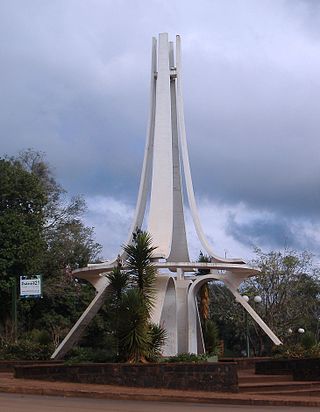
This is a demography of Argentina including population density, ethnicity, economic status and other aspects of the population.

Misiones is one of the 23 provinces of Argentina, located in the northeastern corner of the country in the Mesopotamia region. It is surrounded by Paraguay to the northwest, Brazil to the north, east and south, and Corrientes Province of Argentina to the southwest.

Oberá, formerly Svea, is a city in the interfluvial province of Misiones, Argentina, and the head town of the Oberá Department. It is located 96 km east of the provincial capital Posadas, on National Route 14, and about 1,150 km north of Buenos Aires. It has 63,960 inhabitants according to the 2010 census [INDEC].

Immigration to Argentina began in several millennia BCE with the arrival of different populations from Asia to the Americas through Beringia, according to the most accepted theories, and were slowly populating the Americas. Upon arrival of the Spaniards, the native inhabitants of Argentine territory were approximately 300,000 people belonging to many Indigenous American civilizations, cultures, and tribes.

Argentina has a racially and ethnically diverse population. The territory of what today is Argentina was first inhabited by numerous indigenous peoples. The first white settlers came during the period of Spanish colonization, beginning in the 16th century. The Spaniards imported African slaves, who would go on to become the first Afro-Argentines. Following independence from Spain in the 19th century and well into the 20th century, numerous migration waves took place, with Argentina being the second most popular destination for migrants in the early 20th century, after the United States. Most of these migrants came from Europe.
Swedish Argentines are Argentine citizens of Swedish descent, as well as Swedish-born people who reside in Argentina. The history of Swedish settlement in Argentina took place principally in the mid to late 19th century, when Swedish people arrived in Argentina. Many Swedes came to Argentina for economic reasons and in order to start a new life. Swedes also helped build Argentina, in particular helping to build Argentina's railroads in the mid 19th century.

Ukrainian Argentines are Argentine citizens of Ukrainian descent or Ukraine-born people who reside in Argentina. Ukrainian Argentines are an ethnic minority in Argentina. Estimates of the Ukrainian and/or Ukrainian-descended population range 1,000,000 people. Many Ukrainian Argentines are of Jewish descent. Currently, the main concentrations of Ukrainians in Argentina are in the Greater Buenos Aires area, with at least 100,000 people of Ukrainian descent, the province of Misiones, with at least 55,000 Ukrainians, and the province of Chaco with at least 30,000 Ukrainians. In Misiones Province Ukrainians constitute approximately 9% of the province's total population. In comparison to Ukrainians in North America, the Ukrainian community in Argentina tends to be more descended from earlier waves of immigration, is poorer, more rural, has less organizational strength, and is more focused on the Church as the center of cultural identity. Most Ukrainian Argentines do not speak the Ukrainian language and have switched to Spanish, although they continue to maintain their ethnic identity.

German Argentines are Argentines of German ancestry as well as German citizens living in Argentina. They are descendants of Germans who immigrated to Argentina from Germany and elsewhere in Europe. Some German Argentines originally settled in Brazil, then later immigrated to Argentina. Although Germany as a political entity was founded in 1871, the German language and culture have traditionally been more important than the country of origin, as the basis of the ethnic identity. Today, German Argentines make up the fifth-largest ethnic group in Argentina, with over two million citizens of Volga German descent alone.

The General Urquiza Railway (FCGU), named after the Argentine general and politician Justo José de Urquiza, is a standard gauge railway of Argentina which runs approximately northwards from Buenos Aires to Posadas, with several branches in between. It was also one of the six state-owned Argentine railway companies formed after President Juan Perón's nationalisation of the railway network in 1948. The six companies were managed by Ferrocarriles Argentinos which was later broken up during the process of railway privatisation beginning in 1991 during Carlos Menem's presidency.

Polish Argentines are Argentine citizens of full or partial Polish ancestry or Poland-born people who reside in Argentina. Poland was the fourth largest net migrants contributor after Italy, Spain and Germany. Although it is hard to give an exact number of Polish immigrants to Argentina, as those who immigrated before 1919 carried German, Austrian or Russian passports, it is estimated that between 1921 and 1976, 169,335 Poles permanently settled in the country. Today there are 2,000,000 Argentines of Polish descent. The Polish minority in Argentina is both one of the most significant minorities in Argentina and one of the largest groups of Polish diaspora.

Bilateral relations between the Argentina and Finland, have existed for over a century.
Russian Argentines are people from Russia living in Argentina, and their Argentine-born descendants. The estimates of the number of Argentines of Russian descent vary between 170,000 and 350,000. They are mostly living in Buenos Aires and Greater Buenos Aires.

Austrian Argentines are Argentine citizens of Austrian descent or Austrian-born people who emigrated to Argentina. Many Austrian descendants in Argentina arrived in the country from other parts of Europe when Austria was a unified kingdom with Hungary.
Lebanese Argentine refers to Argentine citizens of Lebanese descent or Lebanon-born people who reside in Argentina. Many of the Lebanese Argentines are descendants of immigrants cultural and linguistic heritage and/or identity, originating from what is now Lebanon.
Portuguese Argentines are Argentines of Portuguese descent or a Portugal-born person who resides in Argentina. Portuguese Argentines are one of the biggest portugueses communities in the world.

Patricia Ocampo is an Argentine activist involved in community development and creation of libraries in Misiones Province. By 2014, she had worked with community organizers and celebrities to found 20 libraries. The organization she co-founded provides basic assistance to those in poverty and with disabilities and attempts to empower people through education and access to books and libraries. She is also involved in trying to stop child labor in Argentina, specifically in the yerba mate regions.
Estonian Argentines are Argentine citizens of Estonian descent or Estonia-born people who emigrated to Argentina. Argentina is home to the fourth largest Estonian community in the Americas, behind the United States, Canada and Brazil.
Danish Argentines are Argentine citizens of Danish ancestry or people who have emigrated from Denmark and reside in Argentina. Danish immigration to Argentina was particularly intense between the late 19th century and early 20th century. It is estimated that between 1857 and 1930 about 18,000 Danes settled in Argentina. The wave of Danish immigration to Argentina was the third largest in the world, behind those in the United States and Australia, making it one of the largest Danish communities in the world. They also include Faroese and Greenlandic Argentines because of Faroe Islands' and Greenland's status as an autonomous territory of Denmark.













